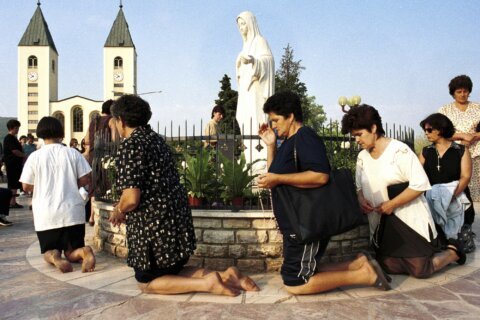What’s in a name? Well, if it’s osteoporosis, osteopenia and osteoarthritis, for starters, a shared prefix. “Osteo” means bone, and that matching descriptor also spells confusion for many seniors, who are disproportionately affected by each of the conditions. Besides sounding similar, a major shared risk factor for the development of these chronic conditions is aging.
Osteopenia and osteoporosis are similar conditions. But from symptoms — or a lack thereof — to how each impacts the body and the ways in which they’re managed, osteoporosis and osteopenia differ completely from osteoarthritis.
Osteoarthritis vs. Osteoporosis
Despite several significant differences, osteoporosis and osteoarthritis mix-ups persist. Many people have only a faint idea that they’re at risk or are just learning about one or both conditions.
Osteoporosis refers to “porous bone,” or a thinning of bone, where the quality and density of bone is decreased, so that it becomes weak and brittle. This puts a person at higher risk for sustaining a fracture. However, there are typically no other noticeable symptoms before a bone break.
“Osteoporosis is the most common metabolic bone disease in the (U.S.) and the world. It is a silent disease until a fracture occurs,” says Dr. Meryl LeBoff, chief of the Calcium and Bone Section and director of the Skeletal Health and Osteoporosis Center and Bone Density Unit at Brigham and Women’s Hospital in Boston. Apart from that, there are generally no outward signs that a person may have osteoporosis, which affects about 10 million in the U.S., predominantly women, according to Healthy People 2030.
By contrast, osteoarthritis is an inflammatory condition that affects the joints — like the hips, knees, spine and joints in the hands. Unlike with osteoporosis, this most common form of arthritiscan cause a range of symptoms. Those include joint stiffness, declining flexibility, bone spurs and, perhaps most noticeably, pain.
[Read: Is Your Knee Pain Worse at Night?]
Are osteoarthritis and osteoporosis related conditions?
Are the conditions linked? The short answer is not really, experts say.
However, they can be related in a few small ways:
— Having both conditions at the same time. Some people have both osteoarthritis and osteoporosis. So while they’re not directly associated, they share certain risk factors, such as age and gender. “Both conditions are more common in women than they are in men — although clearly they both can affect men as well,” says Dr. Andrea Singer, chief medical officer at the Bone Health and Osteoporosis Foundation, division director of Women’s Primary Care and medical director of Bone Densitometry and the Fracture Liaison Service at MedStar Georgetown University Hospital in Washington, D.C.
— Both conditions may be correlated. Past research LeBoff was involved in found that 25% of patients studied with advanced osteoarthritis, who came in to Brigham and Women’s Hospital for joint replacement, also had osteoporosis, according to bone density criteria. “So it really changed the concept that the osteoarthritis patients did not get osteoporosis, when in fact a subset of them do get osteoporosis,” LeBoff says. “It’s important to consider that in some patients.”
— Genetics. Genetics may also put a person at higher risk of developing each condition as well. “Both conditions tend to run in families,” Singer points out. But one condition doesn’t directly cause or raise a person’s risk of developing the other, clinicians say. That said, having one doesn’t protect you against developing the other, either. It was once thought that having OA might protect a person against osteoporosis. In fact, osteoporosis — which is typically diagnosed by scanning bone density — may be obscured by bone growth around joints affected by osteoarthritis. So, osteoporosis can sometimes be obscured during a bone scan test by the presence of OA.
— Related impact on surgical procedures. For those undergoing joint replacement surgery for OA — like knee or hip replacement — having osteoporosis as well can significantly affect how successful the procedure is. Because a replacement joint must be placed in bone, it makes a difference whether that bone is strong or the quality is diminished and the bone mineral density decreased. If you have a bone with osteoporosis, it’s quite possible that the hardware won’t stay in the bone, requiring another operation on the joint.
[READ: How to Recover From Surgery]
Osteopenia vs. Osteoporosis
Osteopenia and osteoporosis are closely related conditions, both characterized by a marked decrease in bone mineral density. Bones with higher bone mineral density are stronger and less likely to break.
Osteoporosis and Osteopenia: What to Know
Osteopenia is a precursor to osteoporosis but isn’t necessarily a disease itself. It’s unlikely you would have signs, symptoms or major complications from osteopenia. However, osteopenia may progress to osteoporosis, which is a greater loss of bone mineral density and can cause injury, like fractures. Preventive care is essential to prevent osteopenia from morphing into osteoporosis.
Osteopenia and osteoporosis causes and risk factors
The biggest cause of osteoporosis and osteopenia is the natural aging process. Bone deteriorates as you age, and the body stops putting its resources into bone formation.
Other causes and risk factors for osteoporosis and osteopenia include:
— Maintaining a sedentary lifestyle.
— Having a body mass index under 18.
— Smoking or drinking.
— Going through menopause.
— Having a nutritional deficiency, especially vitamin D deficiency.
— Taking certain medications, like chemotherapy or selective serotonin reuptake inhibitors.
— Being female. Females are about four times more likely to develop osteopenia.
— Being of white or Asian descent.
[READ Arthritis and Diet: What Foods to Avoid]
How to prevent osteoporosis and osteopenia
Osteoporosis-related fractures are the culprit of over a quarter million hospitalizations each year in the United States.
Start preventing osteoporosis and osteopenia by:
— Eating a healthy, bone-supporting diet. That includes making sure, first and foremost, that a person is getting enough calcium and vitamin D through diet and supplementation as needed. For most adults that equates to at least 1,000 milligrams of calcium. Women over 50 should get at least 1,200 mg of calcium per day. While there’s more variation with vitamin D, experts commonly suggest getting at least 800 International Units, or IU, and some advocate for much more.
— Perform weight-bearing exercises multiple times per week, like walking, pickleball or strength training. Putting weight on bones is important to keep them as strong as possible. And you’ll be doing your joints a favor, too.
— Maintain regular follow-ups with your primary care doctor to monitor your risk factors. In addition, your doctor may recommend medications that reduce bone loss or help build bone. Often patients are prescribed a medication to decrease bone breakdown and then another to stimulate bone formation. The goal is to reduce fracture risk, which can help keep patients on their feet and healthy for longer.
Osteopenia and osteoporosis symptoms
Osteopenia and osteoporosis are often silent conditions. If you don’t get diagnostic testing, you may not notice you have it until after a dangerous fracture occurs.
Those with osteopenia or osteoporosis are afflicted with minor falls that cause broken bones, like a fall from standing height causing a hip fracture. Or, a fracture can occur from a simple stressor as minor as coughing or lifting a heavy box.
Osteoporosis and osteopenia screening and tests
Since osteoporosis is often asymptomatic, experts emphasize the importance of screening. It’s necessary to detect it early on, so it can be managed to reduce fracture risk.
— Women 65 years and older should receive osteoporosis screening, according to the U.S. Preventive Services Task Force. This is to prevent fractures.
— Some postmenopausal women under 65 should also be considered for screening based on a clinical assessment of their risk factors, such as having parents who’ve sustained hip fractures, the independent expert panel recommends.
— There isn’t a firm consensus on screening for osteoporosis in men. However, the National Osteoporosis Foundation recommends that men age 70 and older have a bone density test, and the same for women 65 and older. Those with risk factors for osteoporosis are recommended for screening earlier. And the NOF also advises anyone who breaks a bone after age 50 to have a bone density test.
Bone density test for osteoporosis and osteopenia
Both osteoporosis and osteopenia are diagnosed using a bone mineral density scan, usually a DEXA scan. You receive two key results from your bone mineral density scan:
— T-score. A T-score measures how your bone mineral density compares to that of a healthy 25- to 35-year-old. The T-score is a standard deviation, which tells you how far your results stray from the rest of the group. The higher the T-score, the further your bone mineral density is from the rest of the group, and the more fragile your bone is.
— Z-score. A Z-score is similar to a T-score, except it measures your bone mineral density against your own peers. Your age, ethnicity and sex are taken into account.
According to the International Osteoporosis Foundation, the diagnostic criteria are as follows:
— Normal: T-score -1 and above.
— Osteopenia: T-score between -1 and -2.5.
— Osteoporosis: T-score -2.5 or lower.
— Severe osteoporosis: T-score -2.5 or lower, plus at least one fragility-related fracture.
Treatments for osteoporosis and osteopenia
Other than the aforementioned lifestyle changes, osteoporosis and osteopenia can be treated and prevented with medications.
Common treatments include:
— Bisphosphonates. These are the most common treatment for osteoporosis. Bisphosphonates, like alendronate, can be taken once a week or once a month in pill form. Options like zoledronic acid are given as an infusion once per year. These medications help prevent bone breakdown.
— Hormonal therapies. Selective estrogen receptor modulators, like raloxifene, are less commonly given than bisphosphonates for osteoporosis prevention. They are used for postmenopausal women to prevent bone loss but are also given for breast cancer.
— Calcitonin. Calcitonin can slow bone loss and may be given as a nasal spray or as an injection.
— RANKL inhibitors. RANKL inhibitors prevent bone tissue breakdown. One of the most popular RANKL inhibitors is denosumab, given as an injection.
Can you reverse osteoporosis or osteopenia? While you may not be able to completely reverse osteoporosis or osteopenia, you can maintain your current bone mineral density, prevent fractures and slightly rebuild bone mineral density with medications and lifestyle changes.
Osteoarthritis: What to Know
Osteoarthritis, or degenerative joint disease, is where tissue in the joints breaks down over time. This is due to the wear and tear from using the joints during everyday tasks, like walking. Rheumatoid arthritis, on the other hand, is an autoimmune condition. Osteoarthritis most commonly affects the hands, knees, hips and back and is a major cause for knee and hip replacements.
Osteoarthritis causes and risk factors
Like osteoporosis, the main catalyst for osteoarthritis is aging.
Other causes include:
— Having a BMI over 25.
— Smoking or drinking.
— Overuse of the joints, like being a lifelong runner.
— Family history of osteoarthritis.
How to prevent osteoarthritis
Three main steps to preventing osteoarthritis, according to the Centers for Disease Control and Prevention, include:
— Reducing joint stress. Avoid excessive, repetitive activities, like running. These put stress on the joints and can lead to the development of osteoarthritis.
— Losing weight. The Arthritis Foundation suggests that cutting 10% of your weight can reduce arthritis pain by half.
— Maintaining physical activity. Low-stress exercise can help you maintain your weight and healthy joint movement, like walking or swimming.
Osteoarthritis symptoms
Unlike osteoporosis, osteoarthritis symptoms appear early and are noticeable.
Symptoms include:
— Joint tenderness.
— Joint pain.
— Joint swelling.
Often X-rays are done on the joint or joints affected to check for loss of cartilage — a hallmark of OA — or diminished joint space, which signifies cartilage loss. There may also be fluid buildup in the joint, which is another sign of inflammation.
Treatments for osteoarthritis
Treatment for osteoarthritis varies more than osteoporosis.
— Medications. Anti-inflammatory drugs like ibuprofen are a popular remedy for osteoarthritis. You may also try a pain reliever like acetaminophen.
— Steroid injection. Medical providers can give steroid injections, like hyaluronic acid, which is injected into the joint to lubricate it and reduce pain for a few weeks to a few months.
— Therapy. Physical therapy or occupational therapy can help those with functional issues related to osteoarthritis. If your condition is making it hard to perform daily activities, like walking or writing, these therapies can help.
— Surgical intervention. In more severe cases, a doctor may recommend a total joint replacement.
The Bottom Line
Whether you have osteoporosis, osteoarthritis or osteopenia, clinicians say ongoing management is key. This includes maintaining a healthy lifestyle, taking prescribed medications and going to follow-up appointments. This helps to quell symptoms of osteoarthritis and to lower fracture risk with osteoporosis.
More from U.S. News
What Are the Secrets to Aging Well?
5 Easy Hip Flexor Stretches to Relieve Discomfort and Boost Flexibility
Osteoarthritis, Osteoporosis and Osteopenia: What?s the Difference? originally appeared on usnews.com
Update 04/29/24: This story was previously published at an earlier date and has been updated with new information.







